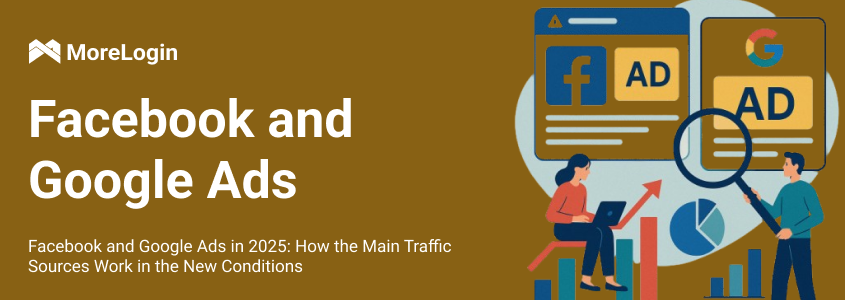
- Product

- Pricing
- Affiliate Program
- Use Cases
- Resource


In 2025, Facebook and Google Ads Still Dominate Affiliate Marketing, Remaining Powerful Channels for Targeting Audiences Across All GEOs
However, with increasing regulations and the adoption of new technologies, paid traffic sources are becoming more complex — yet also more precise in their targeting capabilities. Platforms are focusing on user-friendly content, forcing affiliate marketers to adapt flexibly and implement new campaign strategies.
Below is a fresh overview of the key changes in Facebook and Google Ads already impacting gambling, nutra, and other verticals in 2025.
Facebook is not standing still — its algorithms are getting smarter, and policies are becoming stricter. In 2025, the most notable changes are in targeting, analytics, and campaign automation.
Privacy policies continue to dictate the rules:
Behavioral data from external sites has been excluded; highly personalized audiences based on browsing history can no longer be used.
Targeting by keywords, geo, device, demographics, and current contextual interests remains available.
Test contextual combinations, experiment more with Lookalike audiences, and build segments based on in-platform engagement.
Pixel is Losing Power, Conversion API Takes the Stage
Tracking issues caused by iOS and browser restrictions persist. The Meta Pixel only partially performs its function now. Therefore:
Conversion API has become a must — it's the only way to ensure full data collection.
EMQ (Event Match Quality) is critical — you must improve the accuracy of transmitted data for maximum report relevance.
Solution:
Integrate server-side trackers and always combine the API with Pixel for enhanced analytics.
A clear trend is emerging — reduced reach for ads that lead to external websites. This affects traffic costs and landing page effectiveness.
Facebook lowers the reach of such links, especially to unknown domains.
Internal formats are becoming more effective: Lead Ads, Instant Experience.
Tip:
Mix formats — direct part of your traffic to internal forms and test Instant Experience to reduce click loss.
Automation: Algorithms Do the Work (But Need Monitoring)
Facebook is heavily implementing automation tools:
Advantage+ — the platform automatically selects audience and budget.
CBO and Auto-Bidding — bid and budget management is automated.
Important to remember:
Auto-mode isn’t magic. Without proper monitoring, overspending is possible. Set clear goals and track results in real-time.
In 2025, both Facebook and Google significantly strengthened their anti-fraud systems. The reason is simple: the rise in fake traffic schemes, use of proxies, farmed accounts, and fake engagement — especially in gray areas.
Now, automatic algorithms can detect suspicious activity even before a campaign launches and limit reach or block ad accounts without hesitation.
What Changed in Facebook:
Fake account identification happens faster — if an account shows no organic activity or behaves in a "template" fashion, it gets banned before campaign launch.
Traffic source verification is stricter — suspicious traffic is limited in reach or rejected during ad delivery.
Automatic scanning of creatives and domains — if a domain has a history of violations, its status is downgraded and the campaign may not pass moderation.
What Helps:
Use real accounts, verified domains, and analyze traffic at every stage of the funnel using anti-fraud tools.
With stricter anti-fraud systems and tighter moderation in both Facebook and Google, managing multiple ad accounts (especially in gray or borderline niches) now requires not only expertise but also quality software. In 2025, MoreLogin has become one of the key tools enabling affiliate marketers to scale safely.
Both platforms — Facebook and Google — now actively analyze:
IP addresses and geolocation;
Browser fingerprints (User-Agent, Canvas, WebGL, Fonts);
User behavior and interface interactions;
Cookies, local storage, and fingerprint databases.
When attempting to use multiple accounts in the same browser or if digital footprints overlap — the risk of bans increases significantly.
Google is keeping pace. In 2025, the platform is heavily focused on machine learning, phasing out cookies, and tightening moderation of gray niches.
Bidding algorithms are now almost entirely automated:
In-depth behavioral analysis.
Accurate conversion predictions.
Minimal manual intervention.
Conclusion:
Companies can scale faster, but mistakes in goal setting may lead to losses. It's essential to clearly define KPIs and filter out underperforming bundles.
Google now thoroughly vets advertisers:
Official licenses and quality certifications are required.
Compliance with local laws is strictly checked.
Guide: Prepare a full set of documents in advance, monitor requirements for each GEO, and use more neutral landing pages.
Google has fully phased out support for third-party cookies. Targeting based on cookies not set by your site — such as from trackers, affiliate partners, or DSPs — is no longer supported. This means:
Contextual targeting replaces behavioral targeting.
First-party data takes priority: email lists, phone numbers, and on-site activity.
Dynamic creatives are now a must-have.
Best Practice:
Collect data through quizzes, subscriptions, and lead forms. Use dynamic ad generation based on content and user interaction.
Google has launched improved reporting tools:
A full funnel view from first touchpoint to purchase.
Deep engagement metrics.
Tools to analyze drop-offs and weak points.
Recommendation:
Regularly review the customer journey, identify bottlenecks, and optimize landing pages and creatives based on new analytics insights.
Google is focusing on interactivity:
Interactive videos.
Responsive banners.
Ads that dynamically adapt to the user.
2025 Highlight:
Visual content and mobile-first formats deliver the highest ROI. Don’t cut corners on design and video production.
Affiliate marketing in 2025 is a race to stay ahead. Successful webmasters don't just track updates — they adapt quickly. Automation, legal compliance, and analytics — everything matters.
Facebook and Google remain powerful tools in the hands of those who know how to test, optimize, and face challenges head-on. The future belongs to flexible and adaptive players.